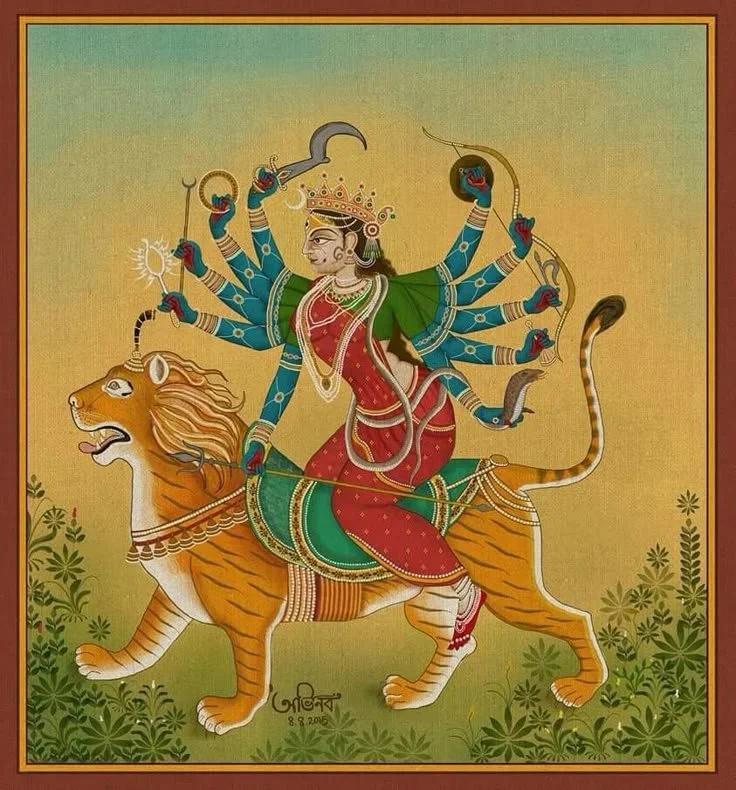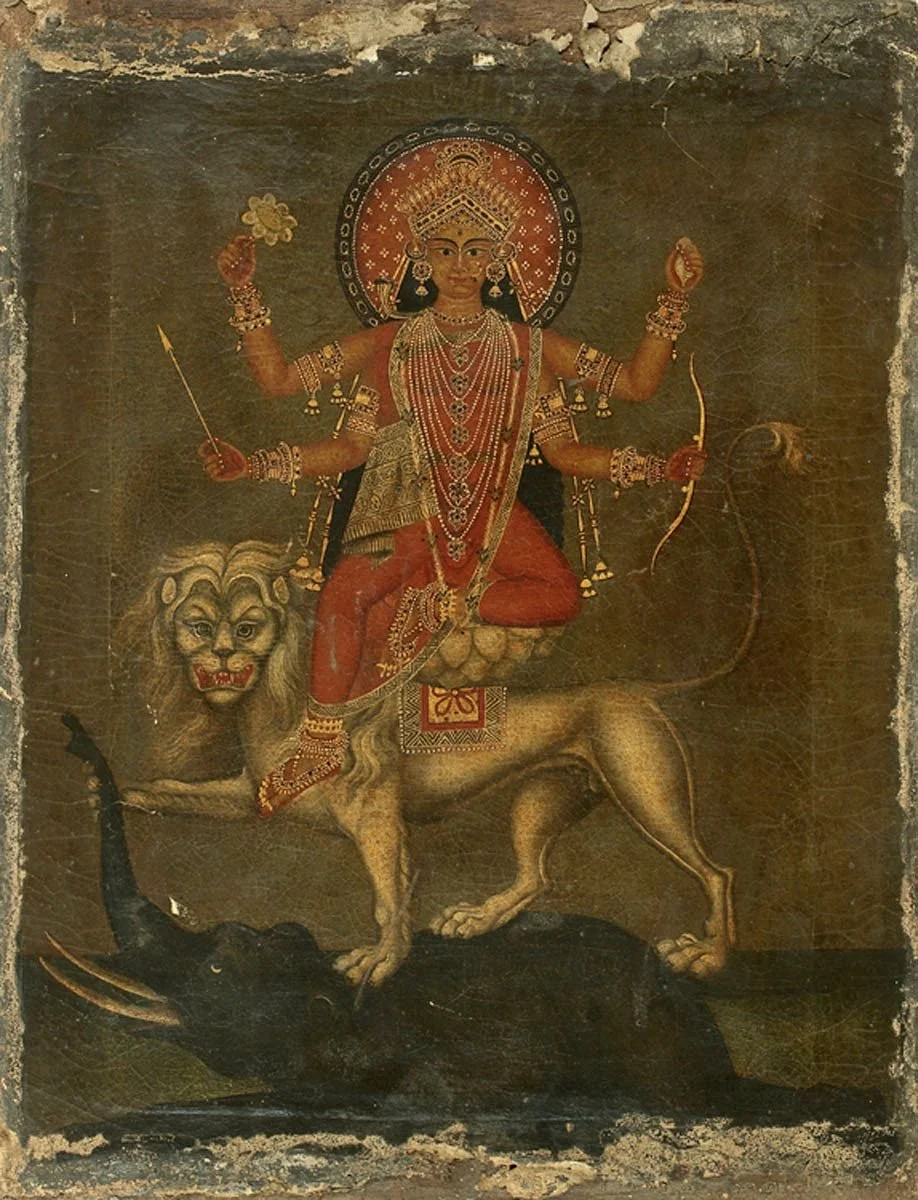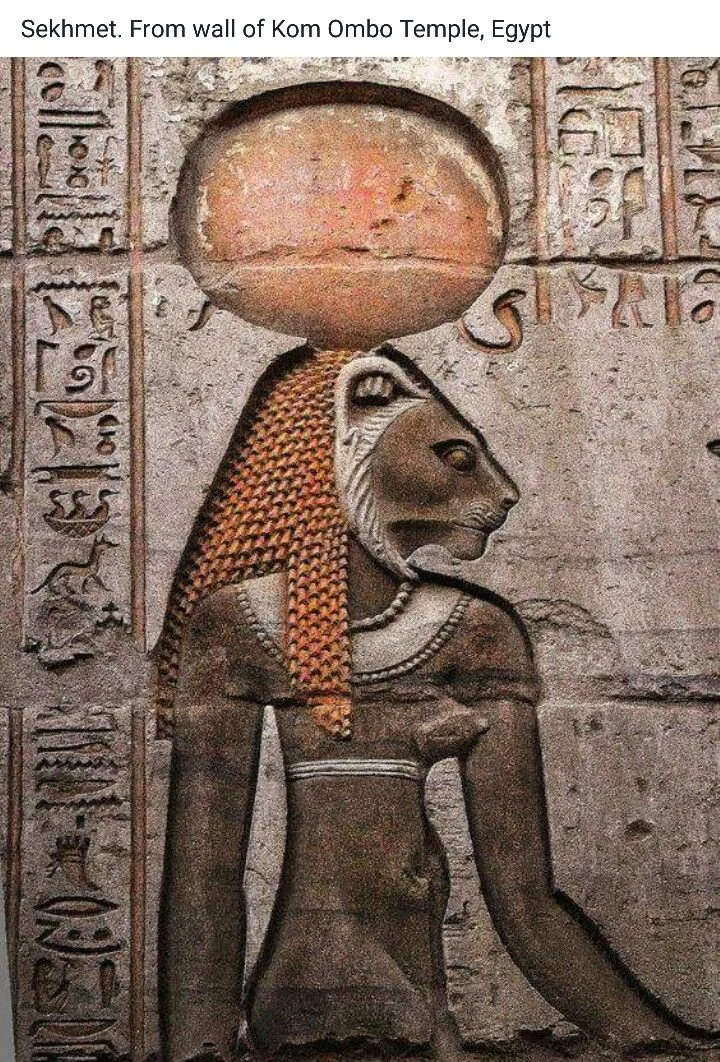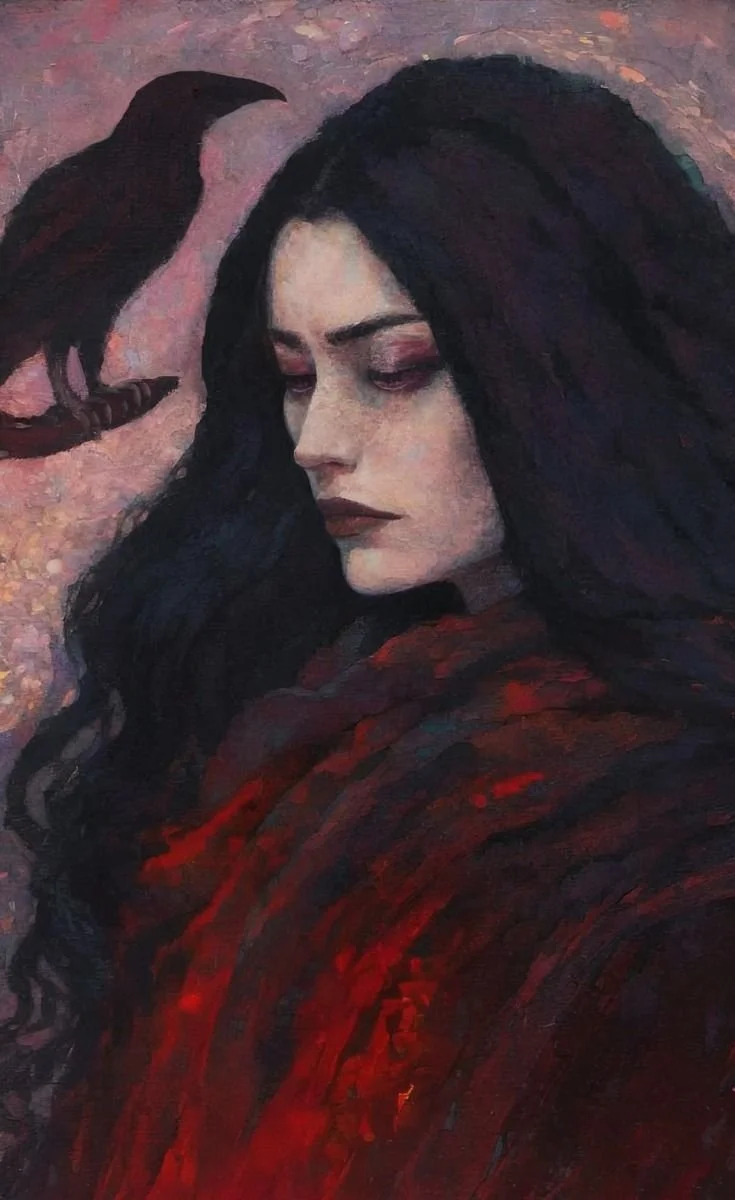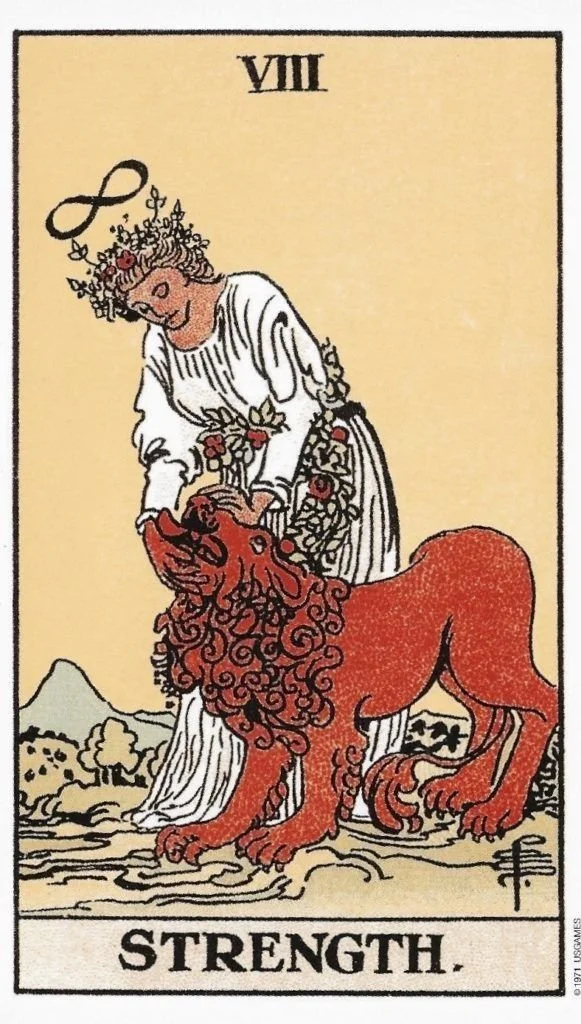Learnings from the Goddess: War and Internal Battles
Goddess Durga
Exploring the fierce faces of the Divine Feminine and how they guide us
from inner conflict toward integration.
Across many pantheons, the Goddess and her manifest forms bring us to realisations and healing processes around various human experiences. She illuminates parts of our psyche, even those we resist, and holds them sacred.
Sacred, to me, in the sense that everything has its time and place. The natural unfolding that arises in its raw and primordial form, has its own medicine—even if it is uncomfortable.
As the Festival of Navratri has been taking place, celebrating the nine manifestation of Hindu Goddess Durga vanquishing nine Asuras (demons), I’ve been called to explore the themes of war and internal battles. Funnily enough, I met them with resistance. As a sensitive soul reclaiming the softer way of life, the very terminology :: war, conquer, vanquish :: triggered me. It stirred dualistic imagery and patriarchal principles I didn’t wish to invite into my awareness.
Yet the Goddess has a way of guiding us toward what we resist most, showing us there is wisdom even here.
The Goddess in her Fierce Forms
Durga / Kali in Hinduism and Indian Epics
Durga is often seen resting gracefully upon a lion or tiger, her many arms holding divine weapons—sword, trident, discus, conch—each one a symbol of the virtues needed to overcome inner and outer demons. She embodies power (shakti) in its purest, most balanced form: fierce yet compassionate, unstoppable yet deeply protective.
In the great cosmic battle, it was from Durga’s third eye that Kali emerged, black as night, wild-haired, and blazing with the fire of truth, to destroy the buffalo demon Mahishasura, who symbolised arrogance and ignorance. In one telling of the story, through her human incarnation Ambika, Durga took form as a radiant woman whose independence and self-possession defied even the gods. When the two Asura brothers sought to claim her, Ambika declared: “If your master wishes to marry me, he must first defeat me in battle.” What follows is not only a tale of divine victory but an allegory of awakening—the triumph of spiritual truth over the ego’s illusion of control
Durga’s mythology reminds us that the fiercest compassion arises when the soft and the strong meet. Her lion symbolises the untamed instincts within us, and her calm poise upon it shows mastery through presence, not domination. She teaches that our battles are not to destroy ourselves, but to restore harmony and rightful order within.
In India today, Durga Puja continues to gather millions in reverence, celebrating her as the protector of cosmic balance and the vanquisher of inner darkness. Beyond festival and faith, her archetype endures in the collective consciousness as the Mother-Warrior—an eternal reminder that strength rooted in love is the greatest power of all.
Athena in Greek Mythology
Athena, born without a mother, sprang fully formed and armoured from the forehead of Zeus himself (mmm… this makes me think of another Goddess). From her first breath, she embodied paradox: the strategist and the nurturer, the warrior and the peacemaker. In myth she is both heroine and, at times, antagonist, reflecting the multifaceted nature of wisdom itself.
Her symbols tell her story. The owl speaks of clear vision and intuitive sight in the darkness. The olive tree, her sacred gift to Athens, represents peace, nourishment, and enduring life. Upon her aegis shield, the head of Medusa reminds us that facing what we most fear can become our protection.
Like Durga, Athena’s myths include moments of violation—Hephaestus’s unwanted advance is one of them. Yet even here, the story becomes a thread of reclamation. Where the masculine oversteps, the feminine asserts her sovereignty. The wound becomes a teaching, reminding us that wisdom requires boundaries, discernment, and the courage to say no.
Though a goddess of battle, Athena ultimately stands for peace—the kind of peace that is earned through clarity, justice, and steadfast integrity. She nourishes, sustains, and guides those who call upon her, ensuring they are equipped for the challenges before them. As patron to heroes, she teaches that victory is not the defeat of another, but mastery of oneself.
Her archetype continues to live within us: the wise strategist who acts from understanding rather than impulse, who wields her intellect and intuition with grace. Athena’s presence in the collective reminds us that true wisdom walks hand in hand with compassion, and that peace, too, is an act of courage.
Sekhmet in Egyptian Mythology
Sekhmet, the lioness-headed Goddess of ancient Egypt, embodies the blazing fire of the sun, the power to destroy, purify, and heal. Known as The Eye of Ra, she was created from the solar fire of the god Ra to annihilate those who rebelled against divine order. Her roar was said to shake the desert, her breath the hot winds that scorched the land. Yet even in her fury, Sekhmet acts not from cruelty but from cosmic balance—she burns away falsehood to restore truth.
When her rage became uncontrollable, legend says Ra poured out vats of beer dyed red to resemble blood. Sekhmet drank deeply, fell into a dreamlike sleep, and awoke transformed. The myth reminds us that unbridled anger, when tempered by compassion and awareness, becomes medicine. The fire that destroys can also cleanse, illuminate, and renew.
Sekhmet’s symbols, the lion, the sun disc, and the ankh, all speak to the sacred cycle of death and rebirth, destruction and vitality. In Egyptian temples she was invoked both by healers and warriors, and her priestesses performed daily rituals of appeasement to keep her power in balance.
In our collective consciousness, Sekhmet endures as the archetype of righteous anger—the energy that rises when injustice, suppression, or stagnation demand transformation. She teaches us to honour our sacred rage as a gateway to truth, to stand firm in integrity, and to remember that healing often begins in the fire of release.
The Morrígan, the Celtic phantom queen
The Morrígan, the Celtic phantom queen, moves through the mists of battle and prophecy. She is the shapeshifter, the crow upon the battlefield, the voice that whispers of destiny and death. To encounter her is to meet the liminal—the space between life and death, victory and loss, endings and beginnings.
In Irish myth, the Morrígan often appears to warriors before great battles, foretelling both triumph and demise. She merges with the land itself—her power tied to sovereignty, fertility, and transformation. In the Táin Bó Cúailnge, she tests the hero Cú Chulainn’s resolve, appearing first as a maiden, then as a wolf, then as a crow—each guise teaching that to deny the cycles of death and rebirth is to deny life itself.
Her symbols: the crow, raven, and river, and the triple aspect of maiden, mother, and crone; remind us that endings are not failures, but necessary thresholds. The Morrígan’s presence asks us to confront the shadow, to honour grief, and to recognise that power lies in surrender as much as in strength.
Within the collective psyche, she is the voice of the dark feminine. She is the truth-teller, the initiator, the one who dismantles illusion so that new life may emerge. The Morrígan walks with us when we release what no longer serves, whispering that the battlefield of the soul is sacred ground for rebirth.
These myths live on not just in temples and ancient texts, but in the collective imagination. They remind us that conflict, courage, and transformation are archetypal forces—not confined to the battlefield but alive in our inner worlds. When the Goddess appears in her fierce forms, she invites us to recognise that destruction and creation are intertwined, and that facing our inner battles can reshape both self and society. These faces of the Divine Feminine do not glorify violence—they reveal that conflict, when harnessed consciously, can be a path of purification. They remind us that sometimes the medicine comes through fire, through the breaking apart of illusions, through a sacred confrontation with what is misaligned within or around us.
Inner Battles as Sacred Alchemy
When speaking of the human soul, our thought patterns, daily upheavals, and spiritual blossoming, the terms “battle” and “conquer” can feel harsh. But just as raw ore is purified in the heat of the forge, or compost transforms decay into nourishment, our inner conflicts serve as the crucible where Spirit and shadow meet.
Fire burns away illusion, Water softens resistance, Air brings perspective, and Earth roots the wisdom we uncover. When we work consciously with these forces—within and without—we begin to see that the battle itself is the alchemy.
The sword becomes a symbol of discernment, cutting through illusions that bind us.
The battle becomes the inner work of dismantling fears, doubts, or old stories.
The victory becomes integration, not dominance—the moment we reclaim lost parts of ourselves.
Each emotion, each resistance, is a raw element awaiting balance. Anger becomes clarity, fear becomes discernment, grief becomes fertile ground for compassion. The alchemist does not reject the storm; she learns to stand in its eye, to feel its power without losing her centre. To approach our inner battles as sacred alchemy is to recognise that every confrontation within us carries a seed of peace, and that peace itself is not passive—it is born of integration. The Goddess does not ask us to suppress our inner conflicts but to listen to them, to honour them as part of the great turning of our personal seasons.
Archetypal Tarot: The Strength Card
The theme of war and inner battles is also found in the Strength card of the Tarot’s Major Arcana. Traditionally depicted as a woman gently opening the jaws of a lion, this image speaks to a different kind of power—not brute force, but the quiet, steady strength of presence and compassion.
Strength is not about domination. It is the courage to be with what is wild, untamed, and primal within us.
The woman does not fight the lion—she meets it with calm, trust, and an open heart. This archetype mirrors the Goddess in her fierce forms: the lion of Durga, the lioness of Sekhmet, the crow of the Morrígan. Each invites us to approach our inner battles not with suppression, but with conscious embrace.
In the collective psyche, the Strength card has become a symbol of resilience and integration—reminding us that true courage is not the absence of fear or conflict, but the willingness to face it with tenderness. It teaches us that the sacred warrior is not only armed with sword and shield but also with compassion, patience, and inner harmony.
Strength whispers that the fiercest battle may not be against the outside world, but against our own resistance to our inner truth.
Reflection + Invitation
This wisdom reinforced the importance of a perspective change. To be able to understand the duality to understand the oneness. I had to feel the trigger, be with the uncomfortable to get to the wisdom. So I wouldn’t close the door on something of value because I didn’t resonate with the language used.
There was still a point of entry for me as I have keen affinities with the Goddess, she guided me to understand, to sit with it so I could unlock what it meant within me and reach the wisdom pearls She blesses us with.
If you think about it—have you ever disregarded something because you didn’t resonate with it at first glance? Perhaps, like me, you’ve avoided the themes of war, conflict, or confrontation.
What happens when you sit with them? Can you find their place within the sacred rhythm of your own life?
Maybe the Goddess appears as the Warrior not to push us into violence, but to remind us that inner battles are sometimes necessary for growth. That fire can purify. That strength can be tender.
A Gentle Practice
If this theme stirs something in you, here is a practice to explore:
Close your eyes and imagine the Goddess beside you in her warrior form—perhaps Durga, Athena, Sekhmet, or the Morrígan. See her as both fierce and compassionate, holding space for your inner battles.
Now bring to mind the Strength card: a woman calmly opening the jaws of a lion, not through force, but through presence and love. Imagine yourself as this figure—meeting the wildness within with steadiness, patience, and trust.
I ask: What untamed part of myself is longing to be met with compassion rather than control? What inner battle softens when I lean into strength of heart instead of force of will?
I breathe deeply, feeling the Goddess and the Strength archetype merging within you. Let their energy remind you that courage is both fierce and tender, and that all parts of your being are worthy of acceptance.
I affirm: I am both fierce and compassionate.
artist unknown
further reading —
On the Divine Feminine & Archetypes
Clarissa Pinkola Estés, Women Who Run With the Wolves: Myths and Stories of the Wild Woman Archetype (Ballantine Books, 1992)
Sharon Blackie, If Women Rose Rooted (September Publishing, 2016)
Alexandra Pope & Sjanie Hugo Wurlitzer, Wild Power: Discover the Magic of Your Menstrual Cycle and Awaken the Feminine Path to Power (Hay House, 2017)
Sylvia Brinton Perera, Descent to the Goddess: A Way of Initiation for Women (Inner City Books, 1981)
On the Goddesses & Their Mythologies
Acharya Shunya, Roar Like A Goddess (Sounds True, 2022)
David Kinsley, Hindu Goddesses: Visions of the Divine Feminine in the Hindu Religious Tradition (University of California Press, 1988)
Richard H. Wilkinson, The Complete Gods and Goddesses of Ancient Egypt (Thames & Hudson, 2003)
Rosalind Clark, The Great Queens: Irish Goddesses from the Morrígan to Cathleen Ní Houlihan (Irish Academic Press, 1991)
Robert Graves, The Greek Myths (Penguin Books, 1955)
On Tarot & Archetypal Symbolism
Sallie Nichols, Jung and Tarot: An Archetypal Journey (Weiser Books, 1980)
Rachel Pollack, Seventy-Eight Degrees of Wisdom: A Tarot Journey to Self-Awareness (Weiser Books, 1980)
Angeles Arrien, The Tarot Handbook: Practical Applications of Ancient Visual Symbols (TarcherPerigee, 1997)

